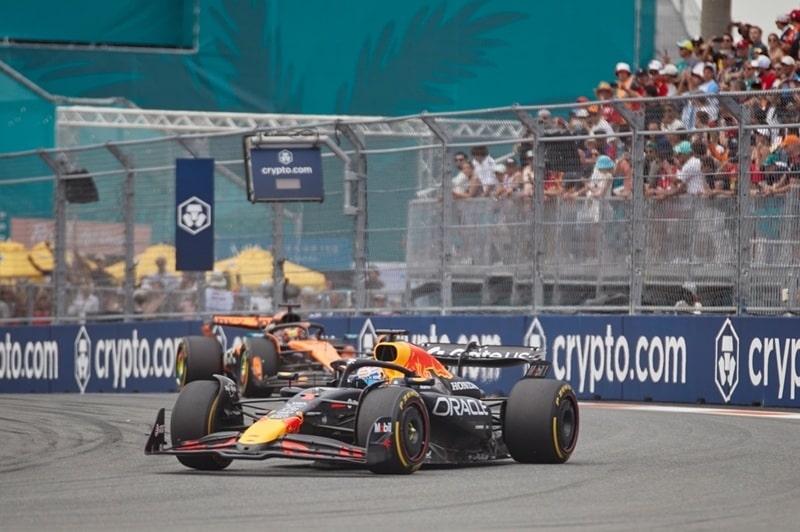Strategic Thrust: The Science Behind F1 Racing Tactics

The focal point of an F1 grand prix weekend revolves around strategic planning, with teams devising initial plans well before reaching the track. Ultimately, tire longevity dictates the strategy, as each driver is confined to 13 sets of dry rubber for the three-day durationcomprising eight sets of the designated soft compound, three of the medium, and two of the hard. Numerous factors influence the decision-making process for completing a race distance in the shortest possible time, and this is where the undercut and overcut strategies come into play.
Data Plays a Key Role
In the dynamic realm of Formula One, data assumes a central role, acting not merely as a silent participant but as the rockstar of the show. From tire compounds to pit-stop strategies, every maneuver on the track is rooted in data-driven decisions, where the stakes are exceptionally high. Distinct tire types exhibit varied performances, with softer tires providing more grip but wearing down rapidly. The degradation, known as "deg," is fundamental to the team's overall strategy.
Approximately six weeks before the race, strategists amass data on variables such as pit lane entry and exit times, average expected pit stop durations, the likelihood of a safety car appearance, and the impact of such an event. This information, combined with predictions of the pace and degradation of their own car and their competitors, serves as the foundation for the baseline strategy for that specific race. This is one of the factors that helped Verstappen win Las Vegas Prix this year.
Practice Sessions Give Real-Time Insights
Upon reaching the track, practice sessions offer real-time insights into tire performance. Teams collect data on degradation for each tire type, both for their own team and their rivals, integrating this information into their simulations for further refinement. Tyre wear is influenced not only by the type and temperature of the tire but also by changes in the car's weight as fuel is consumed during the race. Adding to the excitement, F1 teams utilize advanced telemetry systems that continuously transmit crucial data from the cars to the pit wall.
This real-time feed includes information on tire performance, fuel levels, engine temperatures, and aerodynamics. Strategists and engineers analyze this data on the spot, making instantaneous decisions to optimize the driver's performance and adjust the car settings for optimal speed and precision. Additionally, F1 teams leverage sophisticated weather forecasting tools during the race. If rain clouds appear on the horizon, strategists must determine the opportune moment to switch to wet tires, a decision that can significantly impact the outcome of the race.
Pitstops Play a Crucial Role
Pitstops play a pivotal role, as a slightly worn tire could be the deciding factor between victory and defeat. The pit stop strategy revolves around weighing the advantages of fresh tires against continuing with worn ones. Formula One pitstops and strategy showcase a delicate blend of speed and precision. In the blink of an eye, cars enter the pits, and teams execute tire changes, refueling, and adjustments with robotic efficiency. Strategists use real-time data to determine the optimal moment for pitstops, considering tire wear and track position. Pitstops, though nerve-wracking, are exhilarating spectacles that demonstrate the seamless collaboration between drivers and crews. Every strategic move in F1 exemplifies the teams' expertise in this high-stakes ballet, where well-timed pitstops can transform seconds into the crowning glory of victory. This has been shown in several F1 television series.
Key Strategies in Formula 1
Formula 1 employs two primary strategic maneuvers:
Undercut: This strategy involves a driver entering the pit before the cars ahead to gain a position. Teams opt for the undercut when they believe that fitting fresh tires will provide more speed, resulting in a net gain on the track by the time other cars have completed their pit stops. A DRS train occurs when a series of cars, excluding the lead driver, remain within the DRS range of each other, hindering their ability to advance. The leading cars also have DRS, negating the usual advantage it provides. Teams often respond to DRS trains by attempting the undercut strategy, enabling drivers to lap in clean air and potentially make a net gain after completing the cycle of pit stops.
Overcut: Conversely, the overcut entails letting the leading car pit first and then leveraging the clear air ahead to establish a gap. This strategic move aims to ensure that when the driver eventually pits, they emerge from the pits ahead of the initially leading car.
Impact of Safety Car and Red Flags on Strategy
The safety car and virtual safety car significantly influence strategy by reducing lap times and the cost of pit stops. Under the virtual safety car, a strict delta governs the speed at which cars approach specific track points, minimizing the time lost during pit stops. This situation allows for potential gains in positions as drivers pit under these conditions, as demonstrated by reduced lap time losses compared to green flag pit stops.
During a red flag interruption, drivers can change tires and repair damage without penalties, fulfilling the two-compound obligation without time loss. This eventuality can reshape the race order, disadvantaging those who have already pitted as they cannot regain the lost time. Notably, in the 2020 Italian Grand Prix, Pierre Gasly capitalized on a red flag intervention to secure his maiden victory by strategically pitting under a safety car and benefiting from a subsequent red flag, which allowed him a second free stop and a favorable race outcome. Controversy surrounds the ability of drivers to complete mandatory tire changes under red flag conditions.
Conclusion
The business of Formula 1 racing is not just a high-speed spectacle. It's a captivating dance of strategy and precision, driven by the meticulous analysis of data and split-second decision-making. The science behind F1 racing tactics is a fascinating blend of technological innovation, tire dynamics, and strategic acumen.
This content was created by AI




